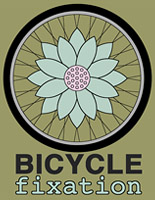"The word derives from from 'dual' and 'single'"--Surlyville
What a great Idea! While I don't think that this is the best option for randonneuring, the 17/20t Dingle cog gave me the perfect combination of gears when touring or commuting with a loaded Yak B.O.B. I have considered using it for randonneuring but I just built up a fixed/fixed Phil wood hub for the longer jaunts and like the idea of having a knobby and road wheel set for the Surly. Regardless of your perceived application, the Dingle cog gives a virtual fixed/fixed wheel and can be run with two front chainrings (similar to a Rivendell Quickbeam) or with a single chainring.
While the Dingle cog comes in 17/19t, 17/20t, or 17/21t combinations, it is only available for use with a 3/32" (narrow or "9 speed") chain width. I'm using a single 42t chainring with my Dingle Cog. I went with the 17/20t cog for 2 reasons. First, I'm only going to be using one chainring. This means that when I change from the 17t to the 20t cog my axle will move forward 3/8 of an inch. While there is plenty of room to move the axle forward almost an entire inch, the type of tires greatly affects the range of movement that rear axle can make. When using wide knobbies (700X45 or 35) I can not move the axle as far forward in the dropout. "Fatties Fit Fine" in my Surly Crosscheck--but only when the axle is in the rear most position. Otherwise, they tend to rub on the rear triangle. Since I wanted to use the dingle on fire roads and some single track, I made a compromise. There is about a 10 gear-inch difference between the 17t and 20t. I expect that I'm still going to have to walk some of the steeper hills and gullies, but this is a great way to play on the road until I get to the trails. The 17/21t missed out based on mud and snow clearance. Yes, 1/8 inch does matter.
The other huge advantage that the Dingle cog gives me is with my B.O.B. trailer. Yes, I've been pulling that thing around on a fixed gear! Up until now I have had a Surly fixed/free hub with "B.O.B. Nutz" instead of the normal solid axle nuts. It is a fantastic setup. I've been running with a 42/15 around town (groceries, recycling) and 42/17t on a few short camping trips. Yet, the 42/17t just gets me to the back roads, and pulling the B.O.B. up hills on uneven, rocky ground was a bit much. The ability to change gear ratios while on the trail, road, or lost is heavenly! 17/anything would win here. For less than the price of 2 cogs I just opened the door to riding [i.e. without pushing or walking the bike] up one canyon and down another!
Finally, skid patches! The 17t tooth cog gives me 17 skid patches on the rear and the 20t cog gives me 10 when running my 42t chainring. Although this probably should be an after thought, I have burned through a few tires and couldn't leave it alone. The 19t and 17t cogs are the best choice if you are going to skid. They produce 17 and 19 skid patches with almost every front chain ring configuration. (51/17 and 38/19 will have 1 skid patch--for a good explanation of skid patches see Sheldon Brown.) In any case, I just didn't see myself skidding around on trial and with a B.O.B. as much as I do around town. The 17/20 won based on gear inches and tire clearance again.
Yes, the chain line is a bit off, but I haven't had any problems to date, and shouldn't unless I let my chain become loose while crossing bumpy terrain. I'll update this post later, once I've been off road with B.O.B" and "Dingle" on some multi-day adventures.

